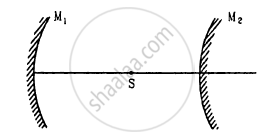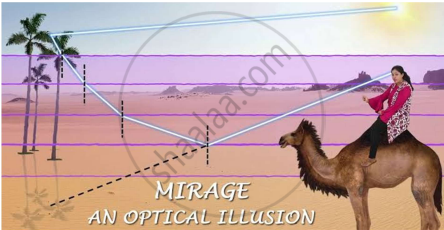Advertisements
Advertisements
प्रश्न
A converging mirror M1, a point source S and a diverging mirror M2 are arranged as shown in figure. The source is placed at a distance of 30 cm from M1. The focal length of each of the mirrors is 20 cm. Consider only the images formed by a maximum of two reflections. It is found that one image is formed on the source itself. (a) Find the distance between the two mirrors. (b) Find the location of the image formed by the single reflection from M2.

उत्तर
Given,
Converging mirror M1 with focal length (f1) = 20 cm
Converging mirror M2 with focal length (f2) = 20 cm
f1 = f2 = 20 cm = f
Point source is at a distance of 30 cm from M1.
As the 1st reflection is through the mirror M1,
u = −30 cm
f = −20 cm
Using mirror equation:
\[\Rightarrow \frac{1}{v} + \frac{1}{u} = \frac{1}{f}\]
\[\Rightarrow \frac{1}{v} + \frac{1}{- 30} = - \frac{1}{20}\]
\[\Rightarrow \frac{1}{v} = - \frac{1}{20} + \frac{1}{30}\]
\[ \Rightarrow \frac{1}{v} = - \frac{1}{60}\]
\[ \Rightarrow v = - 60 \text{ cm }\]
and for the 2nd reflection at mirror M2,
u = 60 − (30 + x) = 30 − x
v = − x, f = 20 cm
Again using the mirror equation:
\[\Rightarrow \frac{1}{30 - x} - \frac{1}{x} = \frac{1}{20}\]
\[\Rightarrow \frac{x - 30 + x}{x(30 - x)} = \frac{1}{20}\]
⇒ 40x − 600 = 30x − x2
⇒ x2 + 10x − 600 = 0
\[\Rightarrow x = \frac{10 + 50}{2} = \frac{40}{2}\]
= 20 cm or − 30 cm
∴ Total distance between the two lines is 20 + 30 = 50 cm
(b) Location of the image formed by the single reflection from M2 = 60 \[-\] 50 = 10
Thus, the image formed by the single reflection from M2 is at a distance of 10 cm from mirror M2.
APPEARS IN
संबंधित प्रश्न
Name the phenomenon responsible for it.
Draw the intensity distribution for the diffraction bands produced due to single slit ?
Write two points of difference between the phenomena of interference and diffraction.
Why does the Sun look reddish at sunset or sunrise ?
What is linearly polarized light?
A parallel beam of light is incident on a converging lens parallel to its principal axis. As one moves away from the lens on the other side on its principal axis, the intensity of light
A point object O is placed on the principal axis of a convex lens of focal length f = 20 cm at a distance of 40 cm to the left of it. The diameter of the lens is 10 cm. An eye is placed 60 cm to right of the lens and a distance h below the principal axis. The maximum value of h to see the image is
A concave mirror having a radius of curvature 40 cm is placed in front of an illuminated point source at a distance of 30 cm from it. Find the location of the image.
A 3 cm tall object is placed at a distance of 7.5 cm from a convex mirror of focal length 6 cm. Find the location, size and nature of the image.
k transparent slabs are arranged one over another. The refractive indices of the slabs are μ1, μ2, μ3, ... μk and the thicknesses are t1 t2, t3, ... tk. An object is seen through this combination with nearly perpendicular light. Find the equivalent refractive index of the system which will allow the image to be formed at the same place.
An optical fibre (μ = 1.72) is surrounded by a glass coating (μ = 1.50). Find the critical angle for total internal reflection at the fibre-glass interface.
A container contains water up to a height of 20 cm and there is a point source at the centre of the bottom of the container. A rubber ring of radius r floats centrally on the water. The ceiling of the room is 2.0 m above the water surface. (a) Find the radius of the shadow of the ring formed on the ceiling if r = 15 cm. (b) Find the maximum value of r for which the shadow of the ring is formed on the ceiling. Refractive index of water = 4/3.
One end of a cylindrical glass rod (μ = 1.5) of radius 1.0 cm is rounded in the shape of a hemisphere. The rod is immersed in water (μ = 4/3) and an object is placed in the water along the axis of the rod at a distance of 8.0 cm from the rounded edge. Locate the image of the object.
Answer the following question in detail.
State the conditions under which a rainbow can be seen.
Pick the wrong answer in the context with rainbow.
State any one difference between a primary rainbow and a secondary rainbow.
A parallel beam of light of wavelength 5890 Å falls normally on a slit of width 0.2 mm. Find the distance between the first minima on the two sides of the central maximum of the diffraction pattern observed on a screen placed in the focal plane of a convex lens of focal length 50 cm. The lens is placed quite close to the slit.
| Case study: Mirage in deserts |
 |
|
To a distant observer, the light appears to be coming from somewhere below the ground. The observer naturally assumes that light is being reflected from the ground, say, by a pool of water near the tall object. Such inverted images of distant tall objects cause an optical illusion to the observer. This phenomenon is called mirage. This type of mirage is especially common in hot deserts. Based on the above facts, answer the following question : |
A diver at a depth 12 m inside water `(a_(µω) = 4/3)` sees the sky in a cone of semi-vertical angle
| Case study: Mirage in deserts |
 |
|
To a distant observer, the light appears to be coming from somewhere below the ground. The observer naturally assumes that light is being reflected from the ground, say, by a pool of water near the tall object. Such inverted images of distant tall objects cause an optical illusion to the observer. This phenomenon is called mirage. This type of mirage is especially common in hot deserts. Based on the above facts, answer the following question: |
A diamond is immersed in such a liquid which has its refractive index with respect to air as greater than the refractive index of water with respect to air. Then the critical angle of diamond-liquid interface as compared to critical angle of diamond-water interface will
